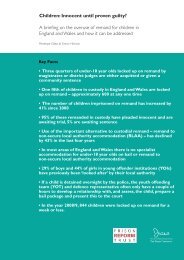HIV and Hepatitis in UK Prisons - Prison Reform Trust
HIV and Hepatitis in UK Prisons - Prison Reform Trust
HIV and Hepatitis in UK Prisons - Prison Reform Trust
Create successful ePaper yourself
Turn your PDF publications into a flip-book with our unique Google optimized e-Paper software.
6 <strong>HIV</strong> <strong>and</strong> hepatitis <strong>in</strong> prisons: address<strong>in</strong>g prisoners’ healthcare needs<br />
4. <strong>HIV</strong> <strong>and</strong> <strong>Hepatitis</strong> C <strong>in</strong> the <strong>UK</strong><br />
There are significantly higher rates of <strong>HIV</strong> <strong>and</strong> hepatitis C <strong>in</strong> prisons than <strong>in</strong> the general population.<br />
<strong>HIV</strong> <strong>in</strong> <strong>UK</strong> prisons<br />
Across the world, rates of <strong>HIV</strong> are higher <strong>in</strong> prisons than amongst the wider population, <strong>and</strong> the <strong>UK</strong><br />
is no exception. In 1997 the Department of Health conducted an anonymous serosurvey of <strong>HIV</strong> <strong>in</strong><br />
prisons <strong>in</strong> Engl<strong>and</strong> <strong>and</strong> Wales. The survey established that there was a prevalence of 0.3 per cent<br />
amongst adult male prisoners <strong>and</strong> 1.2 per cent amongst adult female prisoners 4 . A survey <strong>in</strong><br />
Scottish prisons also <strong>in</strong> 1997 found <strong>HIV</strong> prevalence of 0.3 per cent amongst adult male prisoners <strong>and</strong><br />
0.6 per cent amongst adult women prisoners 5 .<br />
As can be seen from the table below of 2003 <strong>HIV</strong> prevalence rates, even if these 1997 prison<br />
prevalence rates have rema<strong>in</strong>ed unchanged, they would cont<strong>in</strong>ue to be significantly higher than those<br />
of the <strong>UK</strong> population generally. But given the significant <strong>in</strong>creases <strong>in</strong> <strong>HIV</strong> prevalence s<strong>in</strong>ce 1997<br />
(new diagnoses are now at over 7,000 a year, compared with 2,750 <strong>in</strong> 1997), it could well be the<br />
case that prison prevalence rates are now higher than those recorded eight years ago.<br />
Table: <strong>HIV</strong> Prevalence rates <strong>in</strong> the <strong>UK</strong> 2003 (source: Health Protection Agency)<br />
Prevalence<br />
Nation(s) No. PLWH Prevalence rate Prevalence men women<br />
Engl<strong>and</strong> <strong>and</strong><br />
Wales 50,000 0.096% 0.13% 0.055%<br />
Scotl<strong>and</strong> 2,600 0.043% 0.063% 0.031%<br />
N Irel<strong>and</strong> 260 0.015% - -<br />
<strong>Hepatitis</strong> C <strong>in</strong> <strong>UK</strong> prisons<br />
The <strong>Hepatitis</strong> C Action Plan for Engl<strong>and</strong> (2004) estimates the numbers <strong>in</strong> Engl<strong>and</strong> chronically <strong>in</strong>fected<br />
with hepatitis C as approximately 200,000, or 0.4 per cent of the population. 6 Others question this<br />
figure, cit<strong>in</strong>g estimates made by hepatologists as high as 500,000.The <strong>Hepatitis</strong> C proposed Action<br />
Plan <strong>in</strong> Scotl<strong>and</strong> (2005) provides estimates of prevalence for 2004 at 37,500 chronically <strong>in</strong>fected or<br />
0.7 per cent of the population. 7<br />
Only 38,000 of those <strong>in</strong>fected by hepatitis C <strong>in</strong> Engl<strong>and</strong> are diagnosed <strong>and</strong> accord<strong>in</strong>g to a recent<br />
report by the <strong>Hepatitis</strong> C <strong>Trust</strong> the <strong>UK</strong> diagnoses <strong>and</strong> treats a far lower proportion of those with<br />
hepatitis C than France, Germany, Italy or Spa<strong>in</strong>. Early diagnosis <strong>and</strong> treatment can cure between 60<br />
per cent <strong>and</strong> 80 per cent of those treated. Without diagnosis <strong>and</strong> treatment, about a third of those<br />
<strong>in</strong>fected with chronic hepatitis C will go on to develop serious liver disease, which can prove fatal<br />
without a liver transplant. In addition, those undiagnosed are not able to make the lifestyle decisions<br />
which could reduce liver damage <strong>and</strong> prevent further onward transmission of the virus.<br />
It is also the case that hepatitis C rates are higher <strong>in</strong> prisons than <strong>in</strong> the general population. The<br />
same anonymous serosurvey <strong>in</strong> Engl<strong>and</strong> <strong>and</strong> Wales cited above found that the prevalence of hepatitis<br />
C was n<strong>in</strong>e per cent amongst adult male prisoners <strong>and</strong> 11 per cent amongst adult female prisoners.<br />
4 ‘Prevalence of <strong>HIV</strong> <strong>in</strong> Engl<strong>and</strong> <strong>and</strong> Wales 1997' para.33 Department of Health 1998; see also Weild, Gill et al 'Prevalence of <strong>HIV</strong>, hepatitis B, <strong>and</strong> hepatitis C antibodies <strong>in</strong><br />
prisoners <strong>in</strong> Engl<strong>and</strong> <strong>and</strong> Wales: a national survey' Communicable Disease <strong>and</strong> Public Health Vol 3 No 2 June 2000<br />
5 Scottish <strong>Prison</strong> Service Nurs<strong>in</strong>g Service Review 2003 section 2.6 www.sps.gov.uk<br />
6 <strong>Hepatitis</strong> C Action Plan for Engl<strong>and</strong> para.1.1 July 2004 Department of Health<br />
7 <strong>Hepatitis</strong> C Proposed Action Plan for Scotl<strong>and</strong> 2005 Scottish Executive p.14

















